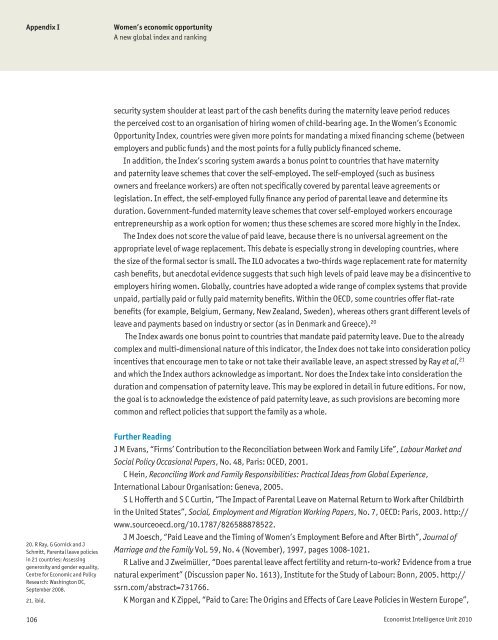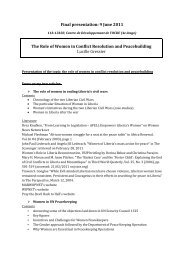Appendix IWomen’s economic opportunityA new global index and ranking11. D Weichselbaumer and RWinter-Ebmer, “The Effectsof Competition and EqualTreatment Laws on Gender WageDifferentials”, <strong>Economic</strong> Policy,Vol. 22, No. 50, April 2007, pages235-287.12. OECD Family database.http://www.oecd.org/els/social/family/database. Last updated July29th 2009.13. Malaysia 1955 EmploymentAct (Sec. 37). Source: Women,Business and the Law database.http://wbl.worldbank.org.14. J Heymann, A Earle and J Hayes,The Work, Family and Equity <strong>Index</strong>.How Does the <strong>Unit</strong>ed States MeasureUp?, Institute for Health and SocialPolicy, McGill University: Montreal,2007. http://www.mcgill.ca/files/ihsp/WFEI2007.pdf15. See for example J De Henau, DMeulders and S O’Dorchai, “Parents’Care and Career. ComparingParental Leave Policies across EU-15”, in Daniela Del Boca and CécileWetzels (eds.), Social Policies,Labour Markets and Motherhood: aComparative Analysis of EuropeanCountries, Cambridge UniversityPress, 2007, pages 63-106.D Del Boca, S Pasqua, C Pronzatoand C Wetzels, “An empiricalanalysis of the effects of socialpolicies on fertility, labour marketparticipation and hourly wagesof European women”, in SocialPolicies, Labour Markets andMotherhood: a Comparative Analysisof European Countries, pages269-270.16. See for example C J Ruhm,“Parental Leave and Child Health”,Journal of Health <strong>Economic</strong>s, Vol.19, Issue 6, November 2000, pages931-960.De Heanau, Meulders and O’Dorchai(2007)J Galtry and P Callister, “Assessingthe Optimal Length of ParentalLeave for Child and ParentalWell-Being”, Journal of FamilyIssues, Vol. 26, No. 2, 2005, pages219-246.17. F Jaumotte, “Female labourforce participation: Past trendsand main determinants in OECDcountries”, OECD <strong>Economic</strong>sDepartment Working Papers No.376, 2003.18. See for example, J Gruber, “TheIncidence of Mandated MaternityBenefits”, American <strong>Economic</strong>Review, Vol. 84, No. 3, 1994.J E Zveglich and Y Rodgers, “TheImpact of Protective Measures forFemale Workers”, Journal of Labour<strong>Economic</strong>s, Vol. 21, No. 3, 2003.Ruhm, op.cit.19. I Oun and G P Trujillo, Maternityat work: A review of nationallegislation. Findings from the ILO’sConditions of Work and EmploymentDatabase (ILO, TRAVAIL: Geneva).international conventions supporting equal treatment of women and men has a strong and significantimpact on the gender wage residual, that is, ratification of equality laws narrows the gender wage gap.(The impact of ratifying the UN Convention on the Elimination of All Forms of Discrimination againstWomen, as well as ILO Convention 111, were analysed in the paper). Conversely, legislation thatprevents women from performing strenuous or dangerous jobs (ILO Conventions 89 and 45 on night andunderground work) is found to increase the gender wage gap in countries that have such laws. 11These positive findings support the inclusion of this indicator in the pilot Women’s <strong>Economic</strong><strong>Opportunity</strong> <strong>Index</strong>.Further ReadingInternational Labour Organisation Employment Trends, “Women in labour markets: Measuring progressand identifying challenges”, http://www.ilo.org/empelm/units/lang--en/WCMS_DOC_ELM_DPT_TRD_EN/index.htm, 978-92-2-123319-0 (web print) (ISBN). ILO: Geneva, 2010Jill Rubery, “Gender Mainstreaming and Gender Equality in the EU: the Impact of the EU EmploymentStrategy”, Industrial Relations Journal, Vol. 33, Issue 5, 2002.Maternity and Paternity Leave ProvisionMaternity leave provisions vary enormously from country to country, from 63 weeks of paid leave inBulgaria 12 to 60 days of leave with pay in Malaysia 13 to no paid leave at all in countries such as the US,Papua New Guinea and Swaziland. 14 Research indicates that the guarantee of maternity leave, particularlypaid leave, will increase women’s labour force participation before giving birth and increases thelikelihood that women will return to the labour market at the end of leave. 15The design of parental leave schemes, including the optimal length of leave, is a complex issue,because it may affect health outcomes for mother and child, women’s employment outcomes, children’scognitive development, and other factors. Research on all of these issues supports paid leave, althoughthere is no agreement on the optimal length. 16 Hence, the baseline standard for this indicator followsthe ILO’s Maternity Protection Convention, 2000 (No. 183), which provides for leave of at least 14 weeks.For example, a study that evaluated changes in female labour force participation in 17 OECD countriesbetween 1985 and 1999 concluded that paid parental leave has a positive impact on female participation.However, as found by other researchers, the marginal effect becomes negative for very long parentalleaves (in excess of the equivalent of 20 weeks of full pay, according to the paper’s estimates). 17 Studieshave also found varying effects of maternity benefits on women’s wages. 18 Overall, there is considerableevidence that short to medium-length maternity leave time (between three and six months) has no ornegligible impact on women’s wages.Who pays for maternity and paternity benefits is a second element of this indicator—the government,the employer, or both parties? The ILO has found that an increasing number of countries are shiftingaway from financing mechanisms that place the direct costs of maternity leave on employers, which is apotential burden to employers and a possible source of discrimination against women. Instead, countriesare gravitating to greater reliance on compulsory social insurance or public funds, or a mixed systemdividing responsibility between employers and social security systems. 19 Having government or the social105 <strong>Economist</strong> <strong>Intelligence</strong> <strong>Unit</strong> 2010
Appendix IWomen’s economic opportunityA new global index and rankingsecurity system shoulder at least part of the cash benefits during the maternity leave period reducesthe perceived cost to an organisation of hiring women of child-bearing age. In the Women’s <strong>Economic</strong><strong>Opportunity</strong> <strong>Index</strong>, countries were given more points for mandating a mixed financing scheme (betweenemployers and public funds) and the most points for a fully publicly financed scheme.In addition, the <strong>Index</strong>’s scoring system awards a bonus point to countries that have maternityand paternity leave schemes that cover the self-employed. The self-employed (such as businessowners and freelance workers) are often not specifically covered by parental leave agreements orlegislation. In effect, the self-employed fully finance any period of parental leave and determine itsduration. Government-funded maternity leave schemes that cover self-employed workers encourageentrepreneurship as a work option for women; thus these schemes are scored more highly in the <strong>Index</strong>.The <strong>Index</strong> does not score the value of paid leave, because there is no universal agreement on theappropriate level of wage replacement. This debate is especially strong in developing countries, wherethe size of the formal sector is small. The ILO advocates a two-thirds wage replacement rate for maternitycash benefits, but anecdotal evidence suggests that such high levels of paid leave may be a disincentive toemployers hiring women. Globally, countries have adopted a wide range of complex systems that provideunpaid, partially paid or fully paid maternity benefits. Within the OECD, some countries offer flat-ratebenefits (for example, Belgium, Germany, New Zealand, Sweden), whereas others grant different levels ofleave and payments based on industry or sector (as in Denmark and Greece). 20The <strong>Index</strong> awards one bonus point to countries that mandate paid paternity leave. Due to the alreadycomplex and multi-dimensional nature of this indicator, the <strong>Index</strong> does not take into consideration policyincentives that encourage men to take or not take their available leave, an aspect stressed by Ray et al, 21and which the <strong>Index</strong> authors acknowledge as important. Nor does the <strong>Index</strong> take into consideration theduration and compensation of paternity leave. This may be explored in detail in future editions. For now,the goal is to acknowledge the existence of paid paternity leave, as such provisions are becoming morecommon and reflect policies that support the family as a whole.20. R Ray, G Gornick and JSchmitt, Parental leave policiesin 21 countries: Assessinggenerosity and gender equality,Centre for <strong>Economic</strong> and PolicyResearch: Washington DC,September 2008.21. ibid.Further ReadingJ M Evans, “Firms’ Contribution to the Reconciliation between Work and Family Life”, Labour Market andSocial Policy Occasional Papers, No. 48, Paris: OCED, 2001.C Hein, Reconciling Work and Family Responsibilities: Practical Ideas from Global Experience,International Labour Organisation: Geneva, 2005.S L Hofferth and S C Curtin, “The Impact of Parental Leave on Maternal Return to Work after Childbirthin the <strong>Unit</strong>ed States”, Social, Employment and Migration Working Papers, No. 7, OECD: Paris, 2003. http://www.sourceoecd.org/10.1787/826588878522.J M Joesch, “Paid Leave and the Timing of Women’s Employment Before and After Birth”, Journal ofMarriage and the Family Vol. 59, No. 4 (November), 1997, pages 1008-1021.R Lalive and J Zweimüller, “Does parental leave affect fertility and return-to-work? Evidence from a truenatural experiment” (Discussion paper No. 1613), Institute for the Study of Labour: Bonn, 2005. http://ssrn.com/abstract=731766.K Morgan and K Zippel, “Paid to Care: The Origins and Effects of Care Leave Policies in Western Europe”,106 <strong>Economist</strong> <strong>Intelligence</strong> <strong>Unit</strong> 2010




